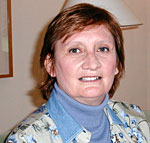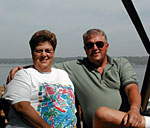Home Again
By Tim Post
June 2001
As the region's population makeup shifts, more Minnesotans are choosing to retire to the the rural towns of their childhood. Retirees see the towns as quiet and affordable destinations, where they're closer to relatives and old friends. But this trend may put pressure on rural communities.
| |
|
|
|
||
At the back of the pharmacy, behind an elevated counter, Dewey Essig and his two assistants avoid collision by ducking and dodging while they answer the phone and fill prescriptions. Essig's workload has quadrupled since he started working in Glenwood 20 years ago.
The bottom line is people are living longer, and need more presciption drugs. But he says it's also because more people are picking Glenwood as a place to retire. "It seems to be a unique thing for this area, you've got hunting and fishing here; if you just want to go out and see the scenery, you can do that, and a lot of them, their roots run deep here, their Scandavian heritage, they tend to come back home," Essig says.
But there's more to it, according to Linda Havir, a St. Cloud State University professor of sociology, who studies aging in rural Minnesota. "We have a generation now that experienced a move from smaller towns and smaller communities and rural areas to the metropolitan areas, now those people are sort of making that migration back and they are real comfortable with that," she says.
When young adults left Minnesota's rural areas in the 1960s for school, work or just to see the world, they weren't really ever expected back. But now more of them are resisting the snowbird instincts which took past generations of Minnesotans to Florida or Arizona, and returning to places filled with memories.
| |
|
|
|
||
Gandrud and his wife, Nancy, have made a comfortable life for themselves on Lake Minnewaska. They could have lived anywhere they wanted. Instead, the Gandruds chose to come back to the place they left more than three decades ago.
"I have several cousins who have retired here on the lake. We were together as children, then we went our own direction as adults, and with family and now as we are retiring, we are all coming back right around the lake again and we find we like each other and we have similar interests," Gandrud says.
Family connections are a major reason many retirees are headed back. Retirees are healthier than a generation ago, so often they're returning to take care of their aging parents, who are living longer.
Minnesota's small towns stand to gain when retirees re-settle. "They bring a vitality, maybe a new way of looking at things, they certainly contribute to the economics of the community, and sometimes they come with all kinds of leadership skills that can be real helpful for the communities," says aging expert Linda Havir.
| |
|
|
|
||
Like many rural Minnesota towns, Glenwood is an attractive retirement destination. While Mayor Gean Olson says no one is keeping track, there is plenty of anecdotal evidence that many of the town's new residents are not really new at all. Olson says Glenwood appreciates it's large population of returning retirees, but she says the town needs to attract more young families, to balance a generationally top heavy population.
Census 2000 figures show the median age in Glenwood is almost 45, that's 10 years older than the statewide median. Attracting young families is very important to area schools, where enrollment has dropped significantly in recent years, as it has in many rural Minnesota towns.
"Young families with children, they really make a community, you know they give you a feeling that there is a future, and so you want to have that, so I think that is why we struggle to, to attract young families as well as retirees to Glenwood." Olson says Glenwood is an easy sell. It's an enticing community perched on a bluff overlooking the state's 13th-largest lake, so there is plenty of recreational activity. And with 2,500 residents, its small-town charm is a draw to many.
Glenwood is drawing young families, just not as many as city leaders would like to see. They blame the local housing crunch. With retirees gobbling up property, it's difficult to find a place to live.
| |
|
|
|
"I think it's been very difficult, we've moved people in and unless you're really a glutton for punishment, where you like to go through building and finding contractors and living within a mess for a year, you probably question your reason for being here because there isn't a lot of spec homes or model homes or things available," Zavadil says.
Zavadil is not waiting for the area's housing situation to change on its own; he's financing a new 22-lot housing development on the east side of town. Zavadil says it's not a money making venture, but rather a way to jumpstart the area's housing market, which is key to the future of the area's economy.
While the issues surrounding retiree migration are already clear, greater effects may be years down the road. For now, the retirees are generally fit and active, but in time, they'll become older citizens who need special care. In 1990, there were almost 69,000 Minnesotans over age 85 statewide. The 2000 census found that number grew to 85,500, with 60 percent of them living outside the seven-county metro area.
City leaders in Minnesota's rural communites are preparing for an aging population, but a crush of retirees could stress those communities even more. And if these towns can't provide the services they need, or their sons and daughters live elsewhere, aging experts say it's likely we'll see a reverse migration, and retirees will leave again.
Next: Nursing Homes



